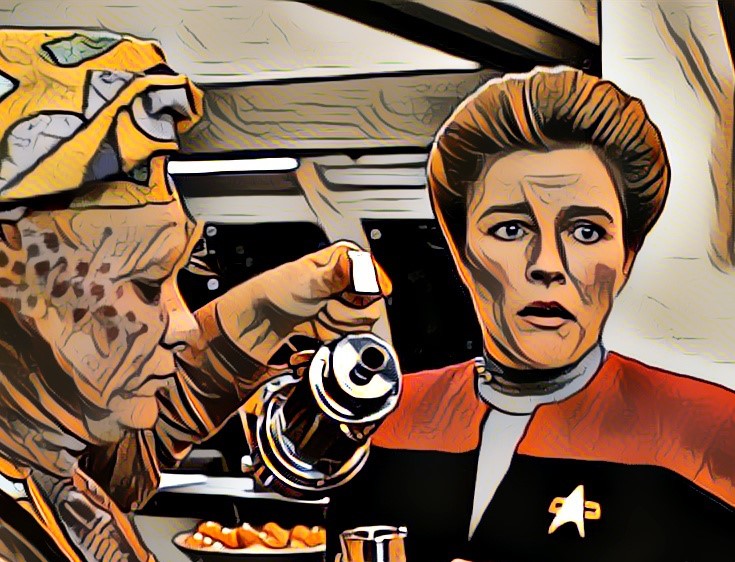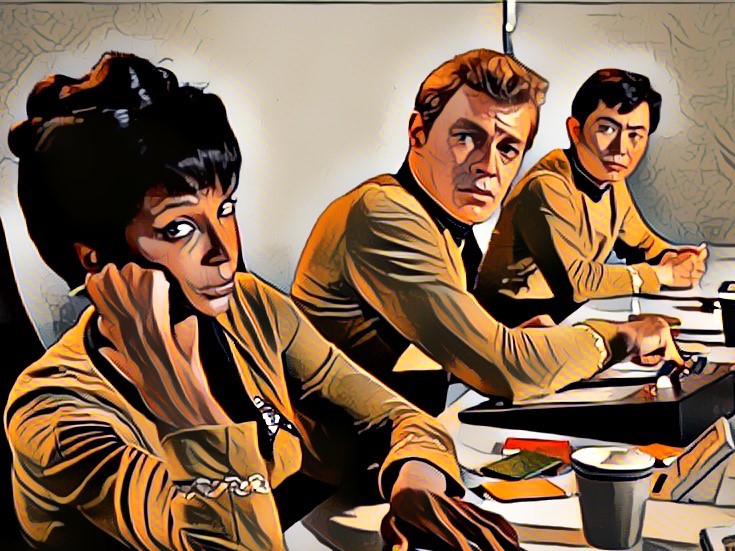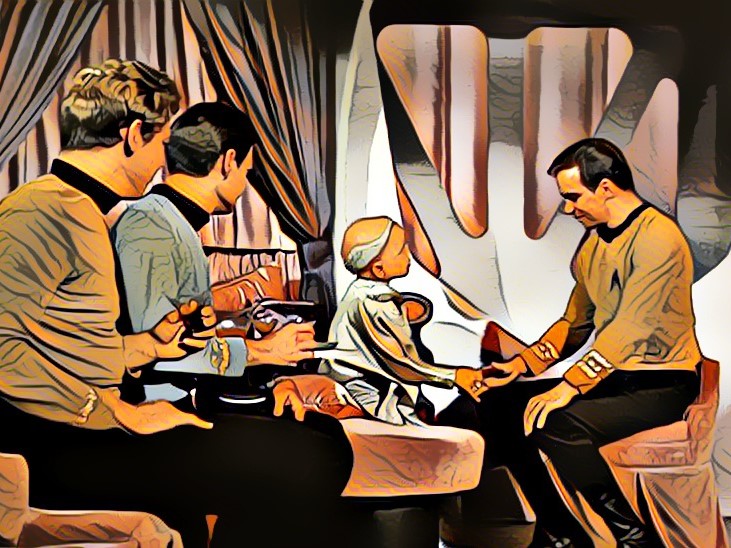Star Trek: The Original Series – “The Corbomite Maneuver” (season 1, episode 10)
Written by Jerry Sohl; directed by Joseph Sargent; first aired in 1966
Captain Kirk’s shirtless exercise and banter with Dr. McCoy are interrupted when the Enterprise is confronted with a strange object that blocks their charted course through the remote reaches of space. Despite Kirk’s attempts to avoid the object without violence, it follows the Enterprise and emits harmful radiation, forcing Kirk to destroy it. This appears to anger the creepy-looking Balok, commander of a massive alien ship, who again traps the Enterprise and gives the crew a short time to make peace with their assorted deities before he destroys them, having judged humans to be violent and dangerous. Their impending doom raises tensions among the crew, and prompts a panic attack from helmsman Bailey. Kirk finally manages to bluff Balok out of blowing them up, and the Enterprise escapes, apparently leaving Balok’s ship critically damaged. But instead of leaving Balok to his fate, Kirk decides to “demonstrate what our high-sounding words mean”, and beams over to Balok’s ship with McCoy and Bailey to rescue their former tormentor. In the process, they discover that Balok isn’t as scary as he seemed, and Bailey becomes an intergalactic exchange student.
VS.
Star Trek: Voyager – “The Cloud” (season 1, episode 6)
Teleplay by Tom Szollosi and Michael Piller; story by Brannon Braga; directed by David Livingston; first aired in 1995
Early in their long trip back home through the Delta Quadrant, the crew is slowly adjusting to their new life aboard Voyager (if you can call Tom Paris recreating his pool-hall days on the holodeck ‘adjusting’). Captain Janeway observes that morale is understandably low, and hopes that a nearby nebula will help with that, by providing resources they can use to power their replicators and make a decent cup of coffee. But once they’re inside the nebula, it turns out to be more dangerous – and harder to get out of – than they’d thought. They’re forced to expend one of their valuable photon torpedoes, and a good chunk of the energy they were trying to conserve, in order to blast their way out of the nebula. But it turns out that the nebula isn’t really a nebula after all: it’s alive, and it’s wounded, now that Voyager has blasted a hole in it. Neelix is angry at Janeway’s plans to take Voyager back inside the nebula and risk their own lives to repair the damage they’ve done, and Janeway takes the opportunity to teach him that “dismissed” is Starfleet captain-speak for “get out”. In the end, the crew lose even more of their precious power reserves, but manage to successfully heal the cloud-creature, keeping those high-minded Federation ideals alive, even if the Federation itself is a bajillion space-miles away.

In my recent series of posts on Discovery’s Mirror Universe arc, I talked a lot about those episodes’ warning against sacrificing our core values in the face of fear. But that got me thinking: what are the core values that the Star Trek franchise models for us, through the fictional Federation and Starfleet? I tend to take it for granted that Trek is about the value of life in all its diverse forms, and the value of curiosity, compassion, and cooperation. But if I’m being honest, that perception is probably based as much on the discourse around Star Trek as it is on the shows themselves; I’m not the only one, I think, who sometimes takes those values as a given, even if they aren’t always obvious on-screen. So, where can I find those values clearly laid out on-screen? Which episodes serve as mission statements for the underlying morality and philosophy of Trek?

In fact, both the original Star Trek and Voyager are careful to include, early in their run, an episode that can serve as that mission statement. These episodes show their respective crews deliberately, explicitly putting the ideals of the Federation into action … and, importantly, they do so in situations where the audience would probably forgive them if they didn’t. Both “The Corbomite Maneuver” and “The Cloud” make a point of showing us how vulnerable the Enterprise and the Voyager are in their respective situations; it’s made abundantly clear to the viewer that the Enterprise’s technology is hopelessly outmatched by that of Balok’s ship, and that the Voyager and its crew are in real danger of running out of the energy they depend on for transportation, defense, and food – for basic survival. Given these facts, I might not have been happy with Kirk or Janeway if they’d prioritized their own survival over that of Balok or the cloud-creature, but I probably wouldn’t have thought it was unforgiveable, either. Honestly, I’ve tolerated far worse from characters on other shows; the modern Golden Age of Television, as we call it, is practically built on the question of how far a character can go before we just can’t root for them anymore. Which is probably why I find these two episodes refreshing when I re-watch them now: against the backdrop of much modern story-telling, Kirk and Janeway’s absolute refusal to even consider abandoning their principles, here, feels almost radical.

Both “The Corbomite Maneuver” and “The Cloud” serve to underscore, or even re-state, the basic premise of their respective series, as laid out in their pilot episodes. “Corbomite”, in particular, looks and feels very much like a pilot, owing to the different uniforms, the unusual camera work that opens the episode, and the one-off character of Bailey who serves as a sort of audience surrogate, a character as impressed, even overwhelmed, by space travel as the show’s creators probably hoped the 1966 audience would be. It aired as the tenth episode of a series that had two pilot episodes already, but it was the first episode to actually be filmed after Star Trek’s second, successful pilot, “Where No Man Has Gone Before”. And in some ways, “Corbomite” would almost make a better pilot than either of the actual pilots that came before it. Or, maybe more accurately, it serves as a good pilot for the franchise Trek is now – where “No Man” works as the pilot for the original Star Trek as a series unto itself – because “Corbomite” does a better job, I think, of capturing the ethics and optimism which are so thoroughly associated with the franchise now. “The Cage” serves as an argument for exploration and against complacency, and “Where No Man Has Gone Before” warns against unchecked advancement and power; these ideas both recur throughout the franchise, of course, and throughout speculative fiction in general. But if anything really sets Trek apart from other TV shows, and from other popular science fiction, it is its optimistic, aspirational portrayal of the Federation as an institution, and “The Corbomite Maneuver” does this much more explicitly and effectively than either of Star Trek’s actual pilot episodes.

By the time Voyager came along, of course, the template for Trek TV shows had already been firmly established, and so Voyager’s pilot episode, “Caretaker”, and the early episodes that followed it, didn’t carry anywhere near as big a burden in establishing audience expectations as the pilots and early episodes of the original series. But “Caretaker”, as a pilot in its own right, carried a different sort of burden. It had a much more specific premise to set up than that of the original series; the audience had to be shown how and why Janeway’s crew and their Maquis counterparts ended up stranded together in such unfamiliar territory so far away, whereas all we really needed to know about Kirk and his crew, plot-wise, was that they were explorers, exploring. “Caretaker” certainly does touch on the role Federation values will play in Voyager; the crew is left stranded in the Delta Quadrant, at that episode’s end, precisely because of an ethical choice that Janeway makes. But since the pilot has to spend the bulk of its time on plot, several of the episodes that come shortly after “Caretaker” carry the responsibility of establishing different elements of the feel of the show, going forward. “The Cloud”, then, is one episode which establishes, early on, what role Federation values will have in the new lives of the Voyager’s crew in the Delta Quadrant, and in their interactions with the locals. Sure, Janeway didn’t waver from those values in “Caretaker”, but that was when she still thought of herself and her crew as residents of the Federation. Now that they aren’t – now that they’re so far away from the Federation that it will take most of their lives to get back to it, if they’re lucky – will they still live by its rules, even if those rules make their trip back to the Federation more difficult?

“The Corbomite Maneuver” and “The Cloud” each start their exploration of Federation and Starfleet values by highlighting the fact that Starfleet is very much a bureaucratic, hierarchical institution. “Corbomite” shows Bailey being reprimanded by Spock, early on, for an emotional outburst on the bridge, and “The Cloud” shows us a strikingly similar interaction between Tuvok and Harry Kim, in an inventive and funny use of communicator technology, when Tuvok tells Kim that statements like “I’ve never seen anything like it!” tend to make the junior staff understandably nervous. On the surface, Kim and Bailey are quite different: Bailey is brash and impulsive, while it’s suggested, here, that Kim is cautious and sheltered, when he worries about holographic wine keeping him awake at night, and claims to remember being in his mother’s womb (!). But they each play the role, in these episodes, of the rough-around-the-edges new officer whose sense of wonder the audience is meant to identify with … and who, importantly, is still relatively new to the institution of Starfleet, and perhaps more likely than other officers to misunderstand or question its hierarchies and protocols. Another scene from “The Cloud” shows Kim arguing with Tom Paris over the unwritten rules of their interactions with the captain, and how those rules might have changed, or maybe should change, in Voyager’s unique situation:
Kim: We should’ve asked her to join us.
Paris: Ensigns don’t invite captains to sit down.
K: Why not?
P: Because they don’t.
K: Well, what’s wrong with showing a little courtesy?
P: Captains don’t want courtesy. They want respect. That’s why they don’t get chummy with the lower ranks.
K: Well, who else is she supposed to “get chummy” with out here? There aren’t many other captains and admirals for her to talk to.
P: If she wants to sit with us, she’ll ask us to join her. That’s the way it’s done.
K: I think you’re working from an old rule book, Paris.

Kim makes a valid point there, and it’s one which is made repeatedly, and often more critically or aggressively, throughout “The Cloud” and “The Corbomite Maneuver”. When Bailey cracks under the pressure of listening to Sulu count down the minutes until Balok’s threatened attack – “What are you, robots, wound-up toy soldiers? Don’t you know when you’re dying?” – it’s at least understandable that he questions the value of protocol and procedure in the face of impending death. And once the tables have seemingly been turned on Balok, it’s again understandable that the crew would be surprised at Kirk’s decision to help him, in light of the threat Balok poses, and the hell he’s just put them through. In “The Cloud”, Neelix and the Doctor point out that Janeway’s plan to help the cloud-creature could jeopardize not only the crew’s immediate safety, but the success of their primary ‘mission’, making it back to the Alpha Quadrant. And as obnoxious as they both are about it, they’re actually right. Where Kirk’s mercy toward Balok is rewarded with the chance to learn about his culture and his advanced technology, the cloud-creature is in no such position to repay Janeway’s decency. Helping it actually costs Voyager a sizeable chunk of the energy reserves Janeway was already worried about when the episode began, making both the crew’s journey, and their survival, more difficult. (Going forward, these sorts of long-term consequences would too often be ignored or forgotten on Voyager, which I think was a real missed opportunity to do something different with this series of Trek … but of course, that’s not this episode’s fault.)

But ultimately, both these episodes make the case that the Federation’s values don’t really mean much if Starfleet officers, as representatives of the Federation, don’t act according to those values all the time, not just when it’s easy to do so. Janeway argues, right from the start of the “The Cloud”, that their unique situation has made sticking to the “old rule book” even more important. “Maybe more than ever now,” she says in her opening log entry, “they need me to be larger than life,” which leads to an excellent bit of early character-building for Janeway: “I only wish I felt larger than life,” followed immediately by “Computer, delete last sentence.” While others on the crew wonder if difficult circumstances call for a different way of doing things, Janeway insists that the whole point of all those Starfleet regulations and protocols is that they be followed under difficult circumstances. (This is something the series will be consistent on, with Janeway taking the same position in episodes like season five’s cliffhanger finale “Equinox”, and the excellent seventh-season episode “The Void”). And in “The Corbomite Maneuver”, Kirk makes a very similar point when he counters McCoy’s reluctance to help Balok by pointedly asking, “What is the mission of this vessel, Doctor?” He answers his own question: “To seek out and contact alien life,” and argues that doing just that with Balok is “an opportunity to demonstrate what our high-sounding words mean.” And as for what those “high-sounding words” might be, exactly, Kirk sums them up nicely earlier in “Corbomite”, when he makes an announcement to reassure his crew after they’ve heard of Balok’s apparent plan to destroy them:
Those of you who have served for long on this vessel have encountered alien lifeforms. You know the greatest danger facing us is ourselves, an irrational fear of the unknown. But there’s no such thing as the unknown, only things temporarily hidden, temporarily not understood. In most cases we have found that intelligence capable of civilization is capable of understanding peaceful gestures. Surely a lifeform advanced enough for space travel is advanced enough to eventually understand our motives. All decks stand by.

Note the words “in most cases,” and “eventually”. Kirk isn’t pretending that the Federation’s philosophy is a substitute for the Enterprise’s shields; he isn’t telling the crew that things will be okay, just because the Federation’s way of doing things is right. He’s asking them to trust that doing things that way is worth it, in the long run, even if things don’t turn out okay in the short term. Janeway makes this point much more bluntly to Neelix, when she reminds him that being aboard a Starfleet vessel means sometimes stepping into harm’s way, not because it couldn’t be avoided, but because it’s the right thing to do … and that if he wants to leave Voyager in his own ship every time that happens, he should just leave permanently, because taking risks for what’s right is what he’s signing up for by staying.

“The Corbomite Maneuver” and “The Cloud” are far from perfect; each has a few cringe-worthy moments typical of the time in which they were made. In “Corbomite”, these moments are provided by early Star Trek’s very weird and uncomfortable dynamic between Kirk and his Yeoman, Janice Rand (a dynamic which, in this episode, gives us the ludicrous line, “I’ve already got a female to worry about – her name’s the Enterprise”). And in “The Cloud”, when Janeway does indeed “get chummy” with the next-highest-ranking officer on the ship, Commander Chakotay, the result is an unbearably earnest and condescending example of Voyager’s poor handling of Chakotay’s Indigenous heritage. I won’t say a lot about that here, except to point you toward an excellent podcast that does a much better job than I ever could of looking at Trek’s indigenous representation in general, including its portrayal of Chakotay and the bizarre story of Voyager’s consultant on Indigenous cultures, a con artist who falsely presented himself as Native American (a phenomenon which, bizarre as it may be, is not just a one-time thing). But if we can get past those issues (without forgiving or forgetting them), “The Corbomite Maneuver” and “The Cloud” each do an impressive job of laying out a mission statements for the values the Trek franchise would at least aspire to, even if they don’t always get it right in the execution.

Next time, we’ll set the “high-minded words” aside for a while, and explore the sillier side of Trek. Yes, Trek really has done not one, but two shrink-ray stories, and we’ll dive into them like a tiny Nurse Chapel taking a contrived fall into a fish tank, when we look at The Animated Series episode “The Terratin Incident”, and DS9’s “One Little Ship”!
